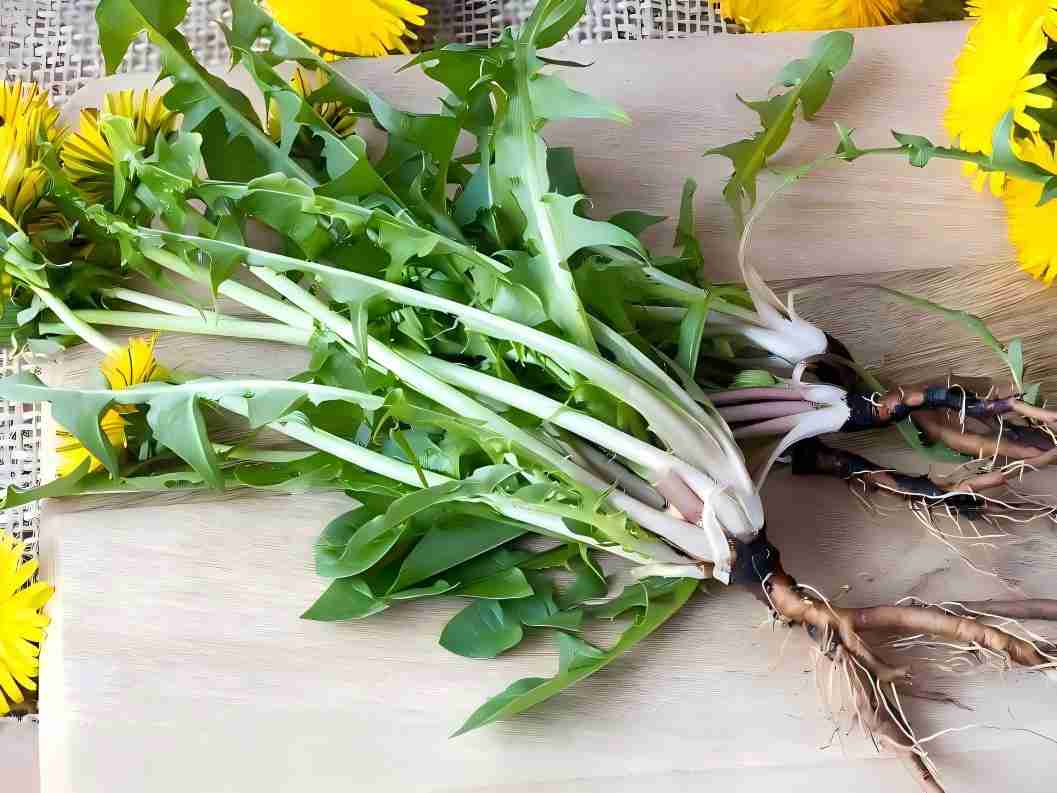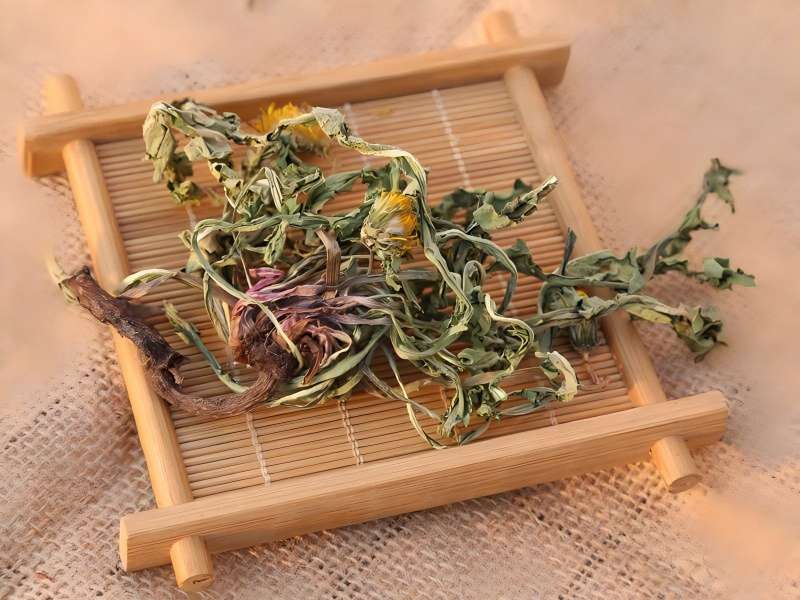What Active Ingredients in Dandelion Extract Powder?
Dandelion is the dried whole grass of the dandelion Taraxacum mongolicum Hand.-Mazz, the Chinese dandelion Taraxacum borealisinense Kitam. and various plants of the same genus in the Asteraceae family. It is commonly known in folk as huanghua langzi, huanghua cao, bubuding, nai zhen cao, etc., and is mainly distributed in medium or low altitude slopes, grasslands, fields, roadsides, riverbanks, etc. [1]. Due to its fast reproduction and wide range of growth, it is widely distributed in its place of origin, and is commonly found in provinces and regions such as North China, Northwest China, Southwest China, and Northeast China [2].
As a medicinal and edible plant, dandelion has high utilization value, and the improvement of its quality control standard system is the key to promoting the inheritance and innovation of traditional Chinese medicine and the high-quality development of the industry [4]. In the 2020 edition of the Chinese Pharmacopoeia, the index for dandelion content determination is chicoric acid [5]. However, the content determination results of a single compound cannot fully and scientifically reflect the quality of dandelion [6]. Therefore, the prediction of dandelion quality markers aims to provide a theoretical basis for improving its quality control standard system.
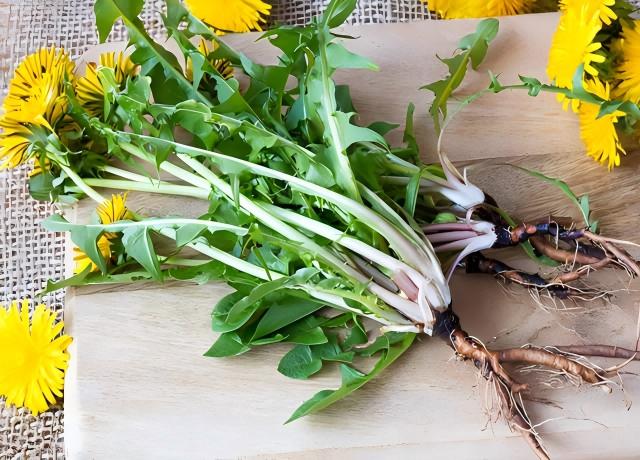
1 Chemical composition
1.1 Flavonoids
Flavonoids are a natural product that is widely found in the plant world. They generally have a basic carbon chain skeleton of C6-C3-C6 and contain two benzene rings connected to a central carbon atom to form a group of biological compounds [7]. Dong Mo et al. [8] determined the flavonoid content in dandelion to be 4.33% using spectrophotometry, which is an important active ingredient in dandelion. The flavonoids isolated from dandelion are shown in Table 1 and their structural formulas are shown in Figure 1.
1.2 Phenolic acids
Phenolic acids are found in most plants and have the basic structure of an aromatic carboxylic acid with a phenolic hydroxyl group substituted [7]. Zhang Yan et al. [12] determined the total phenolic acid content in dandelion to be 12.05% using an improved method, which is a relatively high content. The phenolic acids isolated from dandelion are shown in Table 2 and their structural formulas are shown in Figure 2.
1.3 Terpenoids
Terpenoids are compounds derived from mandelic acid with a structure of two or more isoprene units [7]. The terpenoids isolated from dandelion are shown in Table 3 and their structural formulas are shown in Figure 3.
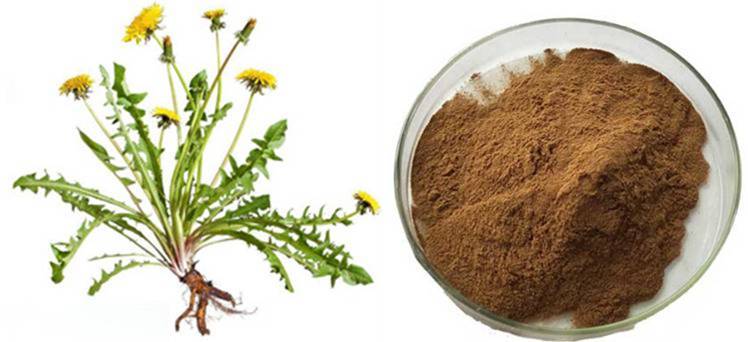
1.4 Sterols
The basic structure of steroidal compounds includes a cyclopenta[b]phenanthrene and three side chains [7]. Chen Qian et al. [17] used a response surface method to determine that the content of sterols in dandelion was 6.73%, and sterols are an important substance contained in dandelion. The sterol compounds isolated from dandelion are shown in Table 4 and their structural formulas are shown in Figure 4.
1.5 Volatile oil compounds
Volatile oils are oily liquid mixtures with aromatic scents, most of which have significant physiological activity [7]. The volatile oil compounds isolated from dandelion are shown in Table 5 and their structural formulas are shown in Figure 5.
1.6 Other compounds
Dandelion extract polysaccharides are mostly composed of monosaccharides such as D-rhamnose, glucose, D-galactose, D-xylose and D-arabinose [21] and are important functional ingredients contained in dandelion [22]. In addition, dandelion also contains alkaloids and other compounds [23].
2 Pharmacological effects
2.1 Pharmacological activities based on the traditional efficacy of dandelion
2.1.1 Clearing away heat and detoxifying
The “Bencao Fenjing” (Compendium of Materia Medica) records that dandelion has bitter and sweet flavors and a cold nature. It can clear away heat and detoxify through its effect on the kidneys [24]. Hahm D H et al. [25] experimentally verified that dandelion can significantly reduce ear swelling, can be used to fight inflammation, and its anti-inflammatory effect is comparable to that of the non-steroidal anti-inflammatory drug indomethacin. Ma Yanni et al. [26] studied the active components in dandelion root and observed that the components of this part have a significant inhibitory effect on the secretion of inflammatory factors and have anti-inflammatory activity. Li Huan et al. [27] extracted plant polysaccharides from dandelion root for research. The results showed that dandelion polysaccharides can inhibit the production of the inflammatory factor NO in cells and have a certain anti-inflammatory effect. Wang Yaqin et al. [28] summarized the clinical conditions of 212 patients with novel coronavirus pneumonia and their responses after medication, and found that using dandelion as the main drug in combination with other traditional Chinese medicines can turn positive nucleic acid patients negative, which can be considered as having antiviral activity.
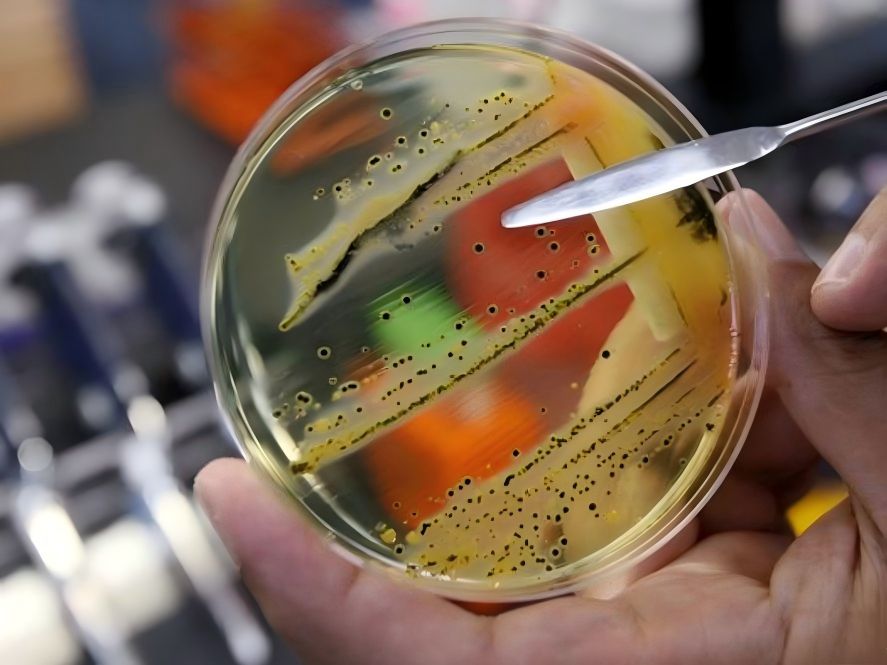
2.1.2 Eliminating abscesses and dispersing lumps
Kaibao Ben Cao (Compendium of Materia Medica from the Kai Dynasty) records: “Sweet in taste, neutral in nature, non-toxic. It is used to treat breast abscesses in women. Boil the dandelion and drink the water, and the abscess will disappear immediately.” [29] Li Biyun et al. [30] proved through clinical trials that dandelion has significant efficacy in treating breast abscesses and parotid abscesses, and also has a certain effect on boils and abscesses in other parts of the body. Zhang Jinhua [31] used dandelion as the main ingredient in the “Dandelion Abscess-Resolving Soup,” which significantly increased the self-healing rate of early breast abscesses and reduced the rate of surgery. Yin Fei et al. [32] developed the Dandelion and Melon Seed Soup, which can treat breast inflammation during breastfeeding caused by milk stasis and help increase the breastfeeding rate.
2.1.3 Diuretic and urination-promoting
The Compendium of Materia Medica says of the dandelion herb: “It is effective in treating boils and abscesses, carbuncles, and poisoned boils, and is also a wonderful treatment for strangury.” [33] Zhang Yanan [34] proved that dandelion has the effect of relieving strangury by conducting a rat experiment on prostatic hyperplasia. Wang Jian [35] used the compatibility of dandelion to treat urinary tract infections, acute and chronic prostatitis, prostatic hyperplasia and other urinary system diseases, with significant efficacy.
2.2 Pharmacological activities based on the expanded functions of dandelion
2.2.1 Antibacterial effect
Tong Yanqing et al. [36] found through bacterial experiments that dandelion extract can inhibit gram-negative bacilli and can be used to treat urinary tract infections. Xu C et al. [37] designed an experiment and found that the number of bacteria in the experimental group with dandelion extract added was significantly reduced, indicating that dandelion extract has a certain antibacterial effect. Qian L et al. [38] found that the oligosaccharides in dandelion have high antibacterial activity against Escherichia coli, Bacillus subtilis and Staphylococcus aureus.
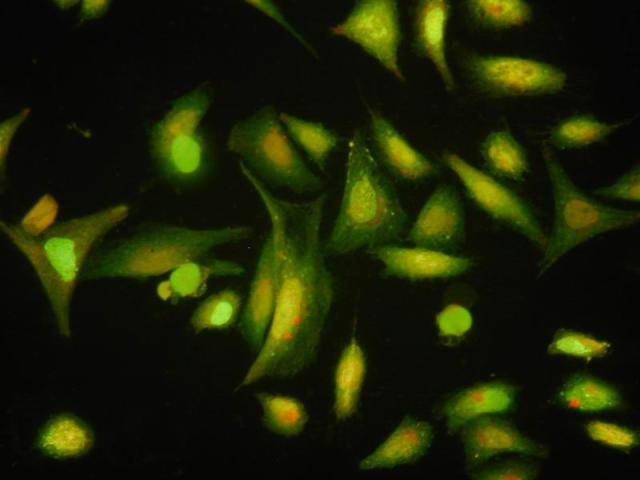
2.2.2 Antitumor effect
Zhang S et al. [39] extracted the active ingredients from dandelion for in vitro anti-tumor experiments, and the results showed that dandelion inulin has anti-tumor activity. Chen Zihan et al. [40] extracted the compounds in dandelion root with water, and verified through cell culture experiments that dandelion root water extract can inhibit the proliferation and growth of cancer cells, and has a certain anti-tumor effect. Sun Yumin [41] detected that the flavonoids in dandelion can affect the growth of human breast cancer cells and promote their apoptosis, which has a certain anti-cancer effect. Zhang Yu et al. [42] observed that dandelion sterols can reduce the reproduction of liver cancer cells to a certain extent, strengthen the resistance of cancer-bearing mice, and improve their immune response to cancer cells.
2.2.3 Hypoglycemic effect
Wirngo F E et al. [43] believe that chicoric acid, perilla sterol, chlorogenic acid and sesquiterpene lactones in dandelion have hypoglycemic effects. Yan Shuang et al. [44] observed through animal experiments that the blood glucose levels of rats given different doses of dandelion extract by gavage were reduced to a corresponding extent, indicating that dandelion extract can lower the blood glucose levels of type 2 diabetic rats and has hypoglycemic activity. Guo Huijing et al. [45] believe that dandelion polysaccharides have a certain inhibitory effect on α-glucosidase and can reduce blood glucose in living organisms.
2.2.4 Antioxidant effect
Hong Xin [46] compared the effect of dandelion extract on the antioxidant stability of canola oil and proved that chicoric acid and chlorogenic acid in dandelion have a significant effect on inhibiting the oxidation of canola oil and have a certain antioxidant effect. Liu Z et al. [47] analyzed the spectroscopic-effect relationship between dandelion fingerprints and antioxidant activity and found that five compounds had antioxidant activity and could be used as candidate markers for dandelion quality: caffeic acid, chlorogenic acid, chicoric acid, isochlorogenic acid A and isochlorogenic acid C.
2.2.5 Gastrointestinal protective effect
Li Y et al. [48] concluded from experimental studies that the gastrointestinal protective substances in dandelion include dandelion sterols, caffeic acid, chicoric acid, chlorogenic acid, luteolin and its glucoside, polysaccharides, inulin and β-sitosterol. Duan Huichun et al. [49] believe that dandelion saponin can protect gastric epithelial cells by interfering with cell signal transduction, inducing related enzymes, regulating cytokines, inhibiting gastric acid secretion, and killing Helicobacter pylori. Zhou Yani et al. [50] found through animal experiments that dandelion polysaccharides can balance the flora in the mouse intestine and protect the intestine to a certain extent.
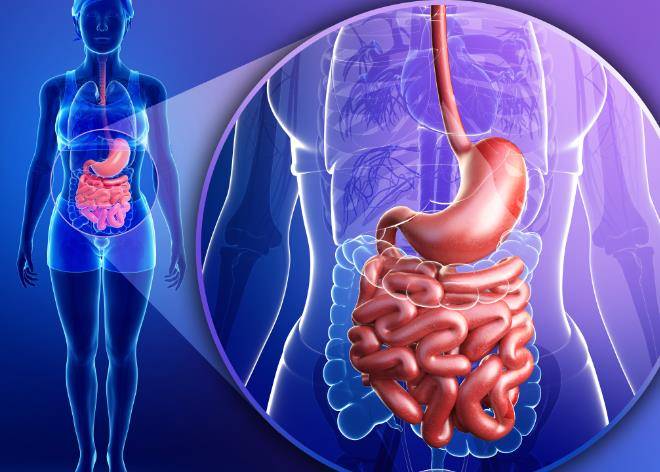
2.2.6 Other effects
Dandelion ethanol extract has a hepatoprotective effect [51]; chlorogenic acid in dandelion has a high binding capacity with sodium salt of bile acid and can significantly reduce blood lipids [52]; dandelion decoction can treat thrombotic external hemorrhoids [53].
3 Quality markers
Although there are many species of dandelion, their chemical compositions are not very different. The main differences lie in their place of origin and stem and leaf morphology [54-55]. According to the 2020 edition of the Chinese Pharmacopoeia, dandelion is the dried whole herb of Taraxacum mongolicum Hand.-Mazz, Taraxacum borealisinense Kitam. and various plants of the same genus in the Asteraceae family. It is stipulated that the dried dandelion product the content of chicoric acid shall not be less than 0.45%, and the content of chicoric acid in the medicinal material shall not be less than 0.30% [5].
The index components for determination are relatively simple, and cannot reflect the overall value of dandelion [56]. Chinese medicine quality markers refer to certain chemical substances that are present in Chinese medicinal materials or products related to traditional Chinese medicine, and may also be produced during processing and preparation. These substances can reflect the safety and effectiveness of the quality of traditional Chinese medicine [57]. Therefore, the predictive analysis of dandelion quality markers is a critical step in establishing a scientific quality control method for dandelion.
3.1 Predictive analysis of quality markers based on evidence of plant phylogeny and chemical composition specificity
According to the data, the genus Taraxacum is extensive and is a large genus of the Asteraceae family. There are about 300 species worldwide, most of which are distributed in temperate to subtropical regions of the Northern Hemisphere, and a few species are distributed in tropical regions of South America. China has 70 species and one variety, with 19 species, one variety and three variants produced in the northeast [58]. Due to the wide distribution of dandelion plants, they are often divided according to their place of origin, such as Mongolian dandelion, Chinese dandelion, and white-margined dandelion [59].
Feng Wei et al. [60] used SSR markers to evaluate the genetic diversity of 82 dandelion germplasm resources. The results showed that the chlorogenic acid, chicoric acid and caffeic acid content of the 82 dandelion germplasm resources all had rich genetic variation. Therefore, chlorogenic acid, chicoric acid and caffeic acid are the main chemical components of dandelion. Studies have shown that dandelion plants contain a variety of active ingredients such as flavonoids, phenolic acids, terpenes, and polysaccharides [61], and have anti-inflammatory, antibacterial, antioxidant, and anti-tumor effects, which are similar to the basic chemical composition and pharmacological effects of dandelions. Among them, flavonoids and phenolic acids in dandelion plants are considered to be the main active ingredients [62]. Therefore, flavonoids and phenolic acids can be used as quality markers for dandelion by analyzing the phylogeny and chemical composition of dandelion plants.

3.2 Predictive analysis of quality markers based on chemical composition and evidence of effectiveness
A literature analysis shows that dandelion extract powder contains a variety of components such as flavonoids, phenolic acids, terpenes, sterols, polysaccharides, and essential oils. Traditional Chinese medicine quality markers [57] can scientifically reflect the effectiveness of traditional Chinese medicine. In order to further determine the quality markers, this section analyzes the effectiveness of dandelion in traditional Chinese medicine.
3.2.1 Correlation between ingredients and traditional efficacy
The effectiveness of traditional Chinese medicine can be reflected through its traditional efficacy and provides a basis for clinical medication [63]. Dandelion has the traditional efficacy of clearing heat and detoxifying, resolving abscesses and lumps, and diuresis and treating stranguria. It is often used in clinical practice to treat boils, mastitis, scrofula, sore throat, lung abscess, and intestinal abscess [2]. The anti-osteoarthritis effect of dandelion is exerted by inhibiting the PI3K/AKT and NF-κB signaling pathways, promoting the activation of the Nrf-2/HO-1 pathway, and limiting the activation of the NF-κB pathway [64]. Dandelion water extract has antiviral effects [65]. The anti-inflammatory and antiviral effects of the two are consistent with the traditional efficacy of dandelion, “clearing away heat and detoxifying”.
Wang Guiying [66] used dandelion plus Huoxue Dan to give intramuscular injections to patients with indurations, and then applied the mixture externally. The efficacy was remarkable, indicating that dandelion can make lumps subside and has the effect of promoting blood circulation and resolving blood stasis, which is consistent with the traditional efficacy of dandelion to “dispel abscesses and resolve lumps”. Huang Mengtao et al. [67] found through experiments that the amount of urine in rats infused with a decoction of dandelion increased, indicating that dandelion can promote the excretion of urine, which is consistent with the traditional efficacy of dandelion to “promote diuresis and treat stranguria”. Phenolic acids such as caffeic acid and chicoric acid have the effect of clearing away heat and detoxifying [68]; rutin has the effect of resolving abscesses and dispersing lumps [69]; and terpene compounds have the effect of inducing diuresis and treating strangury [70]. The above results show that the main pharmacodynamic substance basis of the traditional efficacy of dandelion comes from phenolic acids, flavonoids and terpene components, so quality markers for dandelion can be screened from these.
3.2.2 Correlation between components and traditional medicinal properties
Traditional Chinese medicine believes that the five tastes of Chinese medicine come from different types of compounds [71]. The sweet taste of traditional Chinese medicine comes from the type and amount of organic and inorganic components it contains. Modern chemical research has shown that sugars, saponins, fats, vitamins, proteins, sterols and amino acids are the main sources of the sweet taste of traditional Chinese medicine [72].
Most plants in nature have a bitter taste, which is related to the alkaloids, terpenes, flavonoids and other ingredients they contain. These ingredients are likely to be the main active ingredients with medicinal effects, and often have antioxidant and antitumor effects [73]. Dandelion is sweet and slightly bitter, entering the liver and stomach channels. According to the basic theory of traditional Chinese medicine, the material basis of “sweet” traditional Chinese medicine should have the functional attribute of “sweetness”, i.e., “nourishing and soothing” effects.
The diuretic and urinolytic effects of dandelion are consistent with its “sweet” properties. The material basis of “bitter” Chinese medicinal herbs should have the functional attributes of “bitterness,” i.e., “detoxifying, drying and strengthening” effects. The heat-clearing and detoxifying effects of dandelion are consistent with its “bitter” properties [74]. Studies have shown that compounds such as polysaccharides and sterols are the main sources of the sweet taste of dandelion, while compounds such as volatile oils, terpenes and flavonoids are the main sources of its bitter taste [75]. Therefore, polysaccharides, flavonoids, volatile oils, terpenes and sterol compounds in dandelion can be used as the main choices for quality markers.
3.2.3 Correlation between ingredients and modern pharmacological effects
Liu Xu et al. [76] found that isochlorogenic acid A and oleanolic acid contained in dandelion have antibacterial effects. Yang Chao et al. [20] found in experiments that dandelion volatile oil can effectively inhibit the growth of breast cancer cell line MCF-7, and has certain antitumor effects. Guangzhi L et al. [77] found that dandelion sterols can inhibit cardiovascular aging and have antioxidant effects.
The above ingredients are related to the traditional efficacy of dandelion, and new pharmacological effects have been developed under modern pharmacological research, which can be used as quality markers for dandelion.
3.3 Predictive analysis of quality markers based on the detectability of chemical components
Chemical composition detectability can be used as an important basis for determining quality markers [78]. The 2020 edition of the Chinese Pharmacopoeia documents the method for determining the main component of dandelion, chicoric acid, and establishes the content limit.
Li Chao et al. [79] first used high performance liquid chromatography to determine the content of chlorogenic acid, chicoric acid and caffeic acid in dandelion. This method is simple and easy to operate, and can quickly and conveniently determine the content of these three organic acids in dandelion, and provide a basis for quality control of dandelion medicinal materials. Yang Liqun [80] used high performance liquid chromatography with dual wavelength to determine the content of chlorogenic acid, protocatechuic acid and caffeic acid in dandelion tablets. The method has high stability and repeatability, and is easy and quick to operate. Wang Chaozhong et al. [81] used ultra-high performance liquid chromatography-tandem mass spectrometry to determine the contents of luteolin, luteolin glucoside, caffeic acid and coumarin in dandelion. The method is sensitive, accurate and fast, and can be used to determine the contents of these four index components in dandelion.
An Xinxin et al. [82] used UHPLC-QE in negative ion mode to analyze the components of the total flavonoid fraction of dandelion, and deduced the relative molecular masses of the flavonoid compounds. HPLC was used to determine the contents of quercetin, luteolin and kaempferol in the total flavonoid fraction of dandelion, which is fast, accurate, effective and reliable. Gao Shengping et al. [83] determined the content of flavonoids in dandelion using a fluorescence method. This method has high sensitivity and accuracy, and the results are relatively stable. In summary, flavonoids and phenolic acids are measurable and can be used as the main choice of quality markers for dandelion.
4 Summary
Dandelion is a traditional Chinese medicinal herb with the effects of clearing away heat and toxins, resolving abscesses and lumps, and inducing diuresis. This article summarizes the current research status of dandelion in terms of chemical composition and pharmacological effects. On this basis, a predictive analysis of quality markers for dandelion is carried out from the aspects of plant phylogeny and chemical composition specificity, chemical composition and effectiveness, the predictability of quality markers for dandelion was analyzed from the aspects of plant phylogeny and chemical composition specificity, chemical composition and effectiveness, and
the detectability of chemical composition. It was concluded that the flavonoids and phenolic acids contained in dandelion can be used as the main options for quality markers for dandelion, among which chlorogenic acid, chicoric acid, caffeic acid, and luteolin are consistent with the Q-mark concept and can be used as quality markers for dandelion.
References
[1] Yuan Changqi. Herbal evidence and species identification of dandelion [J]. Chinese Wild Plant Resources, 2001(03): 6-8+17.
[2] Qin Congcong, Du Qinyuan, Zhang Yimin, et al. Herbal evidence research on dandelion [J]. Chinese Pharmacy, 2022, 33(20): 2556-2560.
[3] Liu Juanzi. Liu Juanzi Gui Yifang [M]. 2nd ed. Edited and collated by Yu Wenzhong and Gong Qingxuan. Beijing: People's Medical Publishing House, 1986: 163.
[4] Li Pei, Ma Xiujing. Practice and thinking on establishing a quality control system for new Chinese medicine [J]. China Food and Drug Administration, 2021(09): 16-23.
[5] National Pharmacopoeia Commission. Pharmacopoeia of the People's Republic of China: Part I [S]. Beijing: China Medical Science and Technology Press, 2020.
[6] Xu Qing, Yang Yaojun. The proposal of quality markers (Q-markers): understanding traditional Chinese medicine from a new perspective [C]. China Commodity Society, Proceedings of the 5th National Academic Conference on Traditional Chinese Medicine Commodities of the China Commodity Society, Proceedings of the 5th National Academic Conference on Traditional Chinese Medicine Commodities of the China Commodity Society, 2017: 94-96.
[7] Wu Lijun. Natural Medicinal Chemistry [M]. Beijing: People's Medical Publishing House, 2007.
[8] Dong M, Han T. Optimization of extraction conditions and determination of dandelion flavonoids [J]. Amino Acids and Biological Resources, 2014, 36(03): 72-74.
[9] Wang X, Wang Y. Study on the purification of flavonoids from dandelion by adsorption method [J]. Chemical Research and Application, 2021, 33(07): 1420-1424.
[10] Ling Y, Zhang Y, Cai S, et al. Study on the flavonoids and sterols of dandelion [J]. Chinese Journal of Medicinal Chemistry, 1998(01):49-51.
[11] Shi Shuyun, Zhou Changxin, Xu Yan, et al. Chemical composition of Mongolian dandelion [J]. Chinese Journal of Traditional Chinese Medicine, 2008(10):1147-1157.
[12] Zhang Yan, Yu Zhengyong, Geng Funeng, et al. Optimization of the determination method of total phenolic acid content in dandelion extract [J]. Food Research and Development, 2018, 39(03): 123-126.
[13] Liu Siji. Study on the extraction of dandelion phenolic acid and its inhibition of gastric cancer MGC 803 and liver cancer HepG 2 cell proliferation [D]. Jilin University, 2022.
[14] Zhang Xiaodong, Sun Liya, Meng Ran, et al. Extraction and in vitro functional activity analysis of phenolic acid components from 22 dandelion resources [J]. Jiangsu Agricultural Science, 2021, 49(19): 190-196.
[15] Su Nannan. Research on the terpenoid components and activities of dandelion [D]. Yanbian University, 2019.
[16] Jiang Xing, Zhao Min, Gao Xiaobo, et al. Chemical constituents of eudesmane-type sesquiterpenes in dandelion [J]. Zhongnan Pharmacy, 2016, 14(12): 1293-1297.
[17] Chen Qian, Wang Jianfang, Cao Rang et al. Optimization of dandelion sterol extraction using orthogonal test and response surface methodology [J]. Journal of Shandong Agricultural University (Natural Science Edition), 2022, 53(06): 913-917.
[18] Wang Yaru, Li Yaming, Yang Na et al. Research progress on the chemical composition and pharmacological effects of dandelion plants [J]. Specialty Research, 2017, 39(04):67-75.
[19] Ling Yun, Zhang Weihua, Guo Xiufang, et al. Gas chromatography-mass spectrometry analysis of the components of dandelion volatile oil [J]. Northwest Pharmaceutical Journal, 1998(04):154.
[20] Yang Chao, Yan Qingzi, Tang Jie, et al. Analysis of the components of dandelion volatile oil and its anti-inflammatory and antitumor activity [J]. Chinese Journal of Traditional Chinese Medicine, 2018, 33(07): 3106-3111.
[21] Gao Jinbo, Sun Lina, Teng Yang, et al. Isolation, purification and preliminary analysis of the structure of dandelion root polysaccharide [J]. Chinese Journal of Modern Applied Pharmacy, 2010, 27(10): 905-908.
[22] Li Juan, Zhang Yu. Analysis of the content of effective ingredients in dandelion at different harvest times [J]. Agricultural Science and Technology and Information, 2023(03):150-153.
[23] Jin Yanmei, Zhu Guojun. Study on the extraction process of total alkaloids in dandelion by orthogonal test method [J]. Jiangsu Agricultural Science, 2009(03):329-330.
[24] Yao Lan. Bencao Fenjing [M]. Chen Yi, ed. Shanghai: Shanghai Science and Technology Press, 1989.
[25] Hahm D H, Sur B J, Han D O, etal. Anti-inflammatory activity of dandelion in mice [J]. Journal of Physiology & Pathology in Korean Medicine, 2008, 22(4): 810-814.
[26] Ma Yanni, Wei Yue, Li Zhining, et al. In vitro antibacterial and anti-inflammatory effects of active components of dandelion root [J]. Food and Fermentation Industry, 2022, 48(01): 98-103.
[27] Li Huan, Xu Yanyan, Gao Jinyong, et al. In vitro anti-inflammatory effect of dandelion root polysaccharide [J]. Advances in Animal Medicine, 2019, 40(05): 75-78.
[28] Wang Yaqin, Pang Lijian, Lv Xiaodong, et al. Clinical characteristics and medication patterns of 212 patients with novel coronavirus pneumonia [J/OL]. Chinese Journal of Traditional Chinese Medicine: 1-18 [2023-07-31].
[29] Lu Dusen, Li Fang, et al. Kaibao Ben Cao [M]. Shang Zhijun, ed. Anhui: Anhui Science and Technology Publishing House, 1998.
[30] Li Biyun, Ran Yue, Liu Lihan. Observation of the efficacy of compound dandelion paste in the treatment of breast abscess and parotid abscess [J]. Journal of Shaanxi College of Traditional Chinese Medicine, 1996 (04): 23.
[31] Zhang Jinhua. “Dandelion Abscess-Resolving Decoction” plus hoop ointment for the treatment of 60 cases of early breast abscess [J]. China Medical Guide, 2009, 7(04): 131-132.
[32] Yin Fei, Ni Yi, Liu Wei, et al. Clinical observation on the treatment of lactation mastitis with Dandelion and Melon Seed Decoction [J]. Guangming Chinese Medicine, 2022, 37(15): 2694-2696.
[33] Wang Ang. Essentials of Materia Medica [M]. Yu Li, Chen Zanyu, ed. Beijing: China Traditional Chinese Medicine Publishing House, 1999.
[34] Zhang Yanan. Preparation of fresh dandelion (freeze-dried) decoction pieces and research on their efficacy in clearing away heat and toxins, reducing swelling and relieving stranguria [D]. Henan University of Traditional Chinese Medicine, 2022.
[35] He Ling, Ye Minggang, Tan Hui, et al. Wang Jian's clinical experience with dandelion [J]. Chinese Journal of Basic Medicine in Traditional Chinese Medicine, 2014, 20(08):1133-1134+1136.
[36] Tong Yanqing, Li Hui. Study on the antibacterial effect of purple ground-cherry and dandelion in vitro [J]. Chinese Journal of Microbiology and Immunology, 2003(09):11.
[37] Xu C, Gu Q, Zhao G, et al. Bacteriostatic effects of dandelion and honeysuckle on marine pathogenic bacteria [J]. Journal of Jiangsu Ocean University (Natural Science Edition), 2022, 31(03): 31-35.
[38] Qian L, Zhou Y, Teng Z, et al. Preparation and antibacterial activity of oligosaccharides derived from dandelion[J]. International journal of biological macromolecules, 2014, 64: 392-394.
[39] Zhang S, Song Z, Shi L, etal. A dandelion polysaccharide and its selenium nanoparticles: Structure features and evaluation of anti-tumor activity in zebrafish models[J]. Carbohydrate Polymers, 2021, 270: 118365.
[40] Chen Zihan, Jiang Jihong, Ju Xiuyun, et al. Apoptosis induction of dandelion root aqueous extract in MDA-MB-231 cells and its mechanism of action [J]. Bulletin of Chinese Pharmacology, 2019, 35(03): 353-358.
[41] Sun Yumin. The effect of dandelion flavonoids on the proliferation and apoptosis of human breast cancer MCF-7 cells [D]. Qinghai University, 2020.
[42] Zhang Yu, Ren Feng, Yang Yingying. A preliminary study on the anti-tumor and immunomodulatory effects of dandelion sterols and their mechanisms [C]. Proceedings of the 14th National Immunology Conference Poster Exchange Collection, 2021: 87.
[43] Wirngo, F. E., Lambert, M. N., etal. The physiological effects of dandelion (Taraxacum officinale) in type 2 diabetes. [J] The review of diabetic studies: RDS, 2021,13(02): 113.
[44] Yan Shuang, Li Guangyao, Dai Congshu, et al. The hypoglycemic effect of dandelion extract on type 2 diabetic rats [J]. Food and Machinery, 2020, 36(11): 138-142.
[45] Guo Huijing, Zhang Weida, Chen Guogang. Research on the method of decolorization and protein removal of dandelion polysaccharide and its hypoglycemic activity [J]. Food Research and Development, 2020, 41(03): 24-28.
[46] Hong X. Study on the extraction and antioxidant activity of dandelion chicoric acid and chlorogenic acid [D]. Xihua University, 2022.
[47] Liu Z, Qu J, Ke F, etal. Material Basis Elucidation and Quantification of Dandelion through Spectrum-Effect Relationship Study between UHPLC Fingerprint and Antioxidant Activity via Multivariate StatisticalAnalysis[J]. Molecules, 2022, 27(9): 2632.
[48] Li Y, Chen Y, Sun-Waterhouse D. The potential of dandelion in the fight against gastrointestinal diseases [J]. Journal of Ethnopharmacology, 2022, 293: 115272.
[49] Duan Huichun, Pu Huayun. Research progress on the protective effect of dandelion saponins on gastric epithelial cells and anti-inflammatory effect [J]. Chinese Contemporary Medicine, 2022, 29(20): 30-34.
[50] Zhou Yani, Guo Yaodong, Liu Chengfei, et al. Research on the regulation of intestinal flora and anti-inflammatory effect of dandelion polysaccharide on mice with ulcerative colitis and dysbiosis [J]. Biomedical Engineering and Clinical, 2022, 26(04): 414-419.
[51] Shi H. Preliminary pharmacological and clinical studies on the hepatoprotective effects of dandelion [J]. Chinese Medicine Journal, 1979(12):55-56+23.
[52] Yin J. Extraction process of chlorogenic acid from dandelion leaves and its in vitro lipid-lowering effect [D]. Changchun University of Technology, 2021.
[53] He Wenyue. Fresh dandelion treatment of thrombotic external hemorrhoids [J]. Basic Chinese Medicine Journal, 2000 (05): 64.
[54] Cao Hui, Zuo Hongjuan, Wang Feng, et al. Analysis of growth differences between dandelion species from different origins [J]. Shaanxi Agricultural Science, 2021, 67 (12): 46-48.
[55] Wu J, Ning W. Comparative anatomical study of the leaves of 10 species of dandelion in Northeast China [J]. Feed Research, 2015, (16): 4-11.
[56] Wang S J. We must be objective about the efficacy and toxicity of traditional Chinese medicine [N]. People's Daily, 2006-08-25(005).
[57] Liu Changxiao, Chen Shilin, Xiao Xiaohe, et al. Quality markers for traditional Chinese medicine (Q-Marker): a new concept for quality control of traditional Chinese medicine products [J]. Chinese Herbal Medicine, 2016, 47(09): 1443-1457.
[58] Ge Xuejun, Lin Yourun, Zhai Datong. Preliminary arrangement of the genus Taraxacum in China [J]. Plant Research, 1998, (04): 1-21.
[59] Cao Hui, Zuo Hongjuan, Wang Feng, et al. Analysis of growth differences between dandelion varieties from different origins [J]. Shaanxi Agricultural Science, 2021, 67(12): 46-48.
[60] Feng Wei, Wu Zhe, Meng Ran, et al. Genetic diversity evaluation of dandelion resources based on phenolic acid analysis and SSR markers [J/OL]. Molecular Plant Breeding: 1-20 [2023-07-31].
[61] Zhang, Qingzhe. Research progress on the chemical composition of Taraxacum plants in China [C]//Chinese Pharmaceutical Association, Jiangsu Provincial People's Government. Proceedings of the 2012 Chinese Pharmaceutical Congress and the 12th China Pharmacist Week. [Publisher unknown], 2012: 1701-1706.
[62] Song Xinrui. Extraction and enrichment of the main active ingredients of dandelion and preliminary activity evaluation [D]. Northeast Forestry University, 2020.
[63] Xiao Xiaohai, Guo Yuming, Wang Jiabo, et al. Research on the nature of cold and hot drugs in traditional Chinese medicine based on traditional efficacy [J]. World Science and Technology - Modernization of Traditional Chinese Medicine, 2013, 15(01): 9-15.
[64] Qu Yuhan. Research on the mechanism of action of the active ingredient chicoric acid in dandelion against osteoarthritis and the development of dandelion hanging noodle technology [D]. Chengdu University, 2023.
[65] Xie Shiming, Liu Yingnan, Liu Zihao et al. Screening of effective components of dandelion water extract and observation of in vitro antiviral effect [J]. Shandong Medicine, 2019, 59(33): 39-43.
[66] Wang Guiying. Dandelion plus Huoxuedan external application for the treatment of induration after intramuscular injection [J]. Chinese Folk Therapies, 2000(04):25.
[67] Huang Mengtao, Ling Yun, Zhang Yonglin et al. Experimental study on the diuretic effect of dandelion decoction [C]// Chinese Society of Traditional Chinese Medicine, Beijing Journal of Traditional Chinese Medicine. 1998:53-54.
[68] Ma Lisha. Research on the active components and active ingredients of Forsythia suspensa for clearing away heat and detoxifying [D]. Shanxi University, 2018.
[69] Tan Jing. Research on the chemical basis of activating blood circulation and resolving blood stasis of Xuanhuaxinling Tablet [D]. Jilin University, 2020.
[70] Tang Dandan, Chen Danqian, Cheng Xianlong et al. Research progress on in vitro and in vivo analysis methods of chemical constituents of three diuretic Chinese medicines [J]. Journal of Pharmaceutical Analysis, 2015, 35(03): 377-382.
[71] Zhan Yongli. The four qi and five flavors of Chinese medicine [J]. Chinese Journal of Nephrology Research, 2018, 7(04): 148-150.
[72] Zhang Jingya, Cao Huang, Gong Suhao, et al. Expression of the medicinal properties of the sweetness of traditional Chinese medicine and its application in clinical prescriptions [J]. Chinese Herbal Medicine, 2016, 47(04): 533-539.
[73] Hu Yanan. A study on the relationship between the bitter taste of traditional Chinese medicine and its efficacy of clearing away heat and toxins and activating blood circulation and resolving blood stasis based on biological network mechanisms [D]. Beijing University of Chinese Medicine, 2016.
[74] Zhang Guangji, Yan Can. Basic theory of traditional Chinese medicine [S]. Science Press, 2017.
[75] Chen Jianzhen, Chen Jianming. Discussion on the relationship between the five tastes of traditional Chinese medicine and their chemical constituents and functions [J]. Journal of Zhejiang Chinese Medical College, 1993, (04): 9-10.
[76] Liu X, Lv X, Liang Y et al. Virtual screening of antibacterial agents against PBP2a protein of dandelion based on molecular docking [J]. Journal of Shaanxi University of Science and Technology (Natural Science Edition), 2021, 37(05): 71-79.
[77] Guangzhi L, Dongmei Z, Shizhen W, et al. Protective Role of Taraxasterol against Cardiovascular Aging and Aging-Induced Desensitization of Insulin Signaling. [J]. Frontiers in bioscience (Landmark edition), 2022, 27(11).
[78] Liu Yaochen, Xu Jun, Zhang Hongbing, et al. Quality marker discovery strategy and application based on chemical composition specificity [J]. Chinese Herbal Medicine, 2021, 52(09): 2548-2556.
[79] Li Chao, Dong Zibo, Jiang Jinlai, et al. Determination of chicoric acid, caffeic acid and chlorogenic acid in dandelion by HPLC [J]. Chinese Herbal Medicine, 2015, 46(23): 3577-3580.
[80] Yang Liqun. Simultaneous determination of caffeic acid, chlorogenic acid and protocatechuic acid in dandelion tablets by HPLC-PDA dual-wavelength method [J]. Strait Pharmacy, 2020, 32(12): 45-47.
[81] Wang C Z, Wang M M, Wei Q, et al. Simultaneous determination of four index components in dandelion root and dandelion leaf by ultra-high performance liquid chromatography-tandem mass spectrometry [J]. Journal of Pharmaceutical Analysis, 2020, 39(10): 1404-1408.
[82] An Xinxin, Li Yuanyuan, Zhan Yanfei, et al. Analysis of the components of dandelion total flavonoids and determination of the content of the main components based on UPLC-Q-Exactive and HPLC [J]. New Chinese Medicine and Clinical Pharmacology, 2019, 30(01): 99-105.
[83] Gao Shengping, Wu Xiaohong, Zhang Yaxin, et al. Determination of total flavonoid content in dandelion by fluorescence method [J]. Food Research and Development, 2018, 39(01): 117-121.


 English
English French
French Spanish
Spanish Russian
Russian Korean
Korean Japanese
Japanese